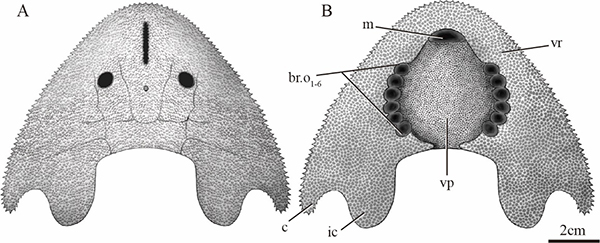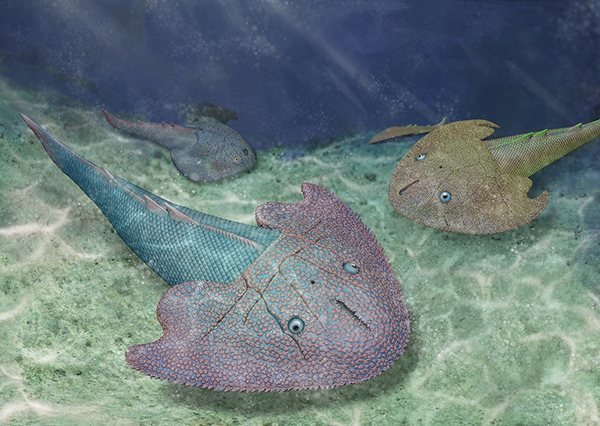| Location: Home > Research > Research Progress |
| The Largest Eugaleaspiform Nochelaspis Reoccurred in the 420-million-years-old “Ancient Fish Kingdom” |
|
New findings on the ~420-million-year-old fossil of Nochelaspis maeandrine found in Qujing help to unveil the mystery of the largest known eugaleaspiform, according to researchers from the Institute of Vertebrate Paleontology and Paleoanthropology (IVPP) of the Chinese Academy of Sciences. Their study was published in Vertebrata PalAsiatica as a cover story. Qujing, located in Yunnan Province, southwestern China, has been acclaimed as the "lost ancient fish kingdom". Its fossil resource, especially the abundant ancient fish fossil resource has decoded numerous secrets of vertebrate evolution. In 1987, ZHU Min, a paleoichthyologist from IVPP, found a complete galeaspid headshield in Qujing. He named it Nochelaspis maeandrine in Vertebrata PalAsiatica. The generic name derived from its large headshield, charmingly naive, while its specific name meant roaming in the water for food. The holotype of N. maeandrine was a nearly complete headshield, which revealed the key morphological characteristics of the dorsal side of the headshield. However, because of the scarcity of material, morphological information from the ventral side of the headshield is absent. "Over the past 30 years, we’ve been trying to find new fossils of N. maeandrine. But it is impossible to carry out excavation, since the south gate of Qujing, where the fossil site located, has become a cultural site," said GAI Zhikun, an associate researcher at IVPP, the corresponding author of the study. Fortunately, the researchers found a previously unnoticed specimen of N. maeandrine among the specimens collected by ZHU Min in 1987. In 2018, they found another nearly complete headshield in the dark grey siltstone near the Miandian Reservoir. These new findings helped the researchers unveil the morphological information from the ventral side of the headshield of N. maeandrine. The early diversified eugaleaspiforms are all small-sized fishes with their headshield length less than 40 mm. The maximum length of the headshield of N. maeandrine has reached about 160mm, indicating that N. maeandrine is the largest known eugaleaspiform to our knowledge. Restoration of Nochelaspis maeandrine in dorsal (A) and ventral (B) views. (Image by YANG Dinghua) The two new specimens redefined the characteristics of N. maeandrine, including triangular headshield, slit-like median dorsal opening (length/width>6) with a sawtooth-like edge, dermal ornamentations composed of coarse stellate tubercles, and the more robust inner cornual process with the posterior end far beyond the posterior margin of the cornual process. Apart from that, the new specimens unravel the mystery of the ventral side of the headshield in N. maeandrine for the first time. The headshield curves ventrally to form a flat ventral rim, embracing a large pear-shaped oralobranchial fenestra. The branchial fenestra is covered by a ventral plate. There are six pairs of successive round branchial openings symmetrically aligned along the lateral margins of the branchial fenestra. The mouth is hypothetical at the front of the oralobranchial fenestra. The ventral plate of N. maeandrine is large enough to have close contact with the ventral rim to shape the branchial openings. "The new evidence suggests that the pouch-like gills of N. maeandrine open to the exterior ventrally by six separated, large, and circular branchial openings," said MENG Xinyuan, the first author of the study. The ventral plate of N. maeandrine is so large that it has closer contact with the ventral rim, whereas the ventral plate of P. liaojiaoshanensis is too small to shape the branchial openings. The external branchial openings or slits are all distributed on both sides of the body in the extant lampreys, hagfishes, and most jawed fishes. By contrast, the branchial openings of N. maeandrine are located ventrally as in modern rays, which indicates a benthic lifestyle dwelling on sandy or muddy substrates in a quiet marine environment. Life Restoration of Nochelaspis maeandrine (Image by YANG Dinghua) Link: http://www.vertpala.ac.cn/CN/10.19615/j.cnki.2096-9899.210727 Contact to GAI Zhikun gaizhikun@ivpp.ac.cn |

